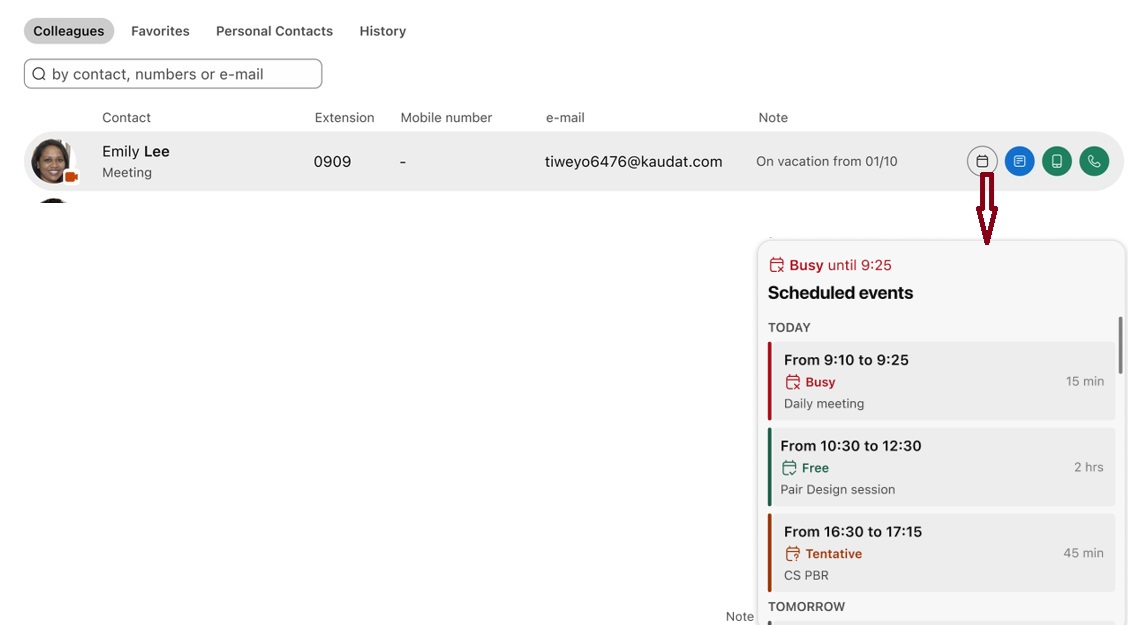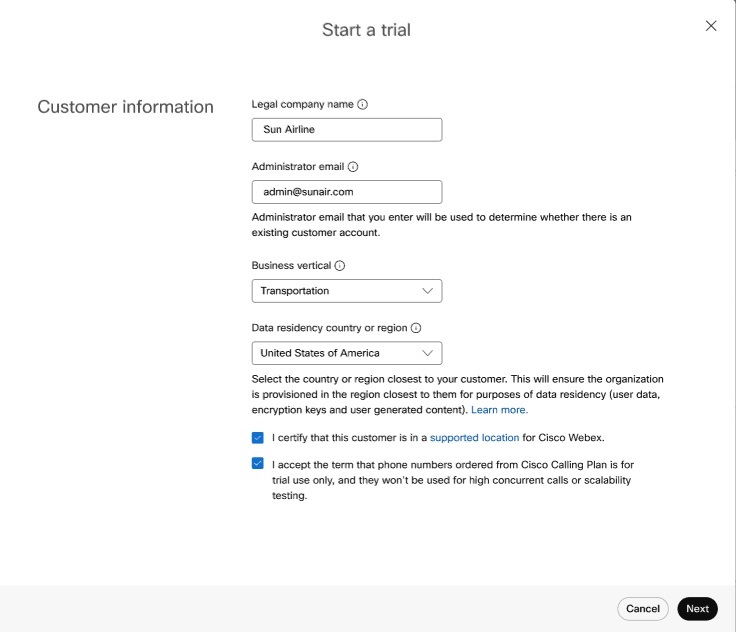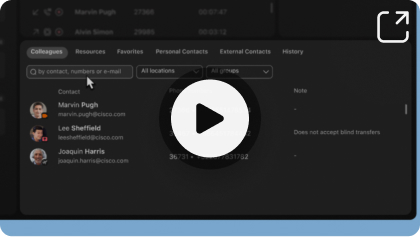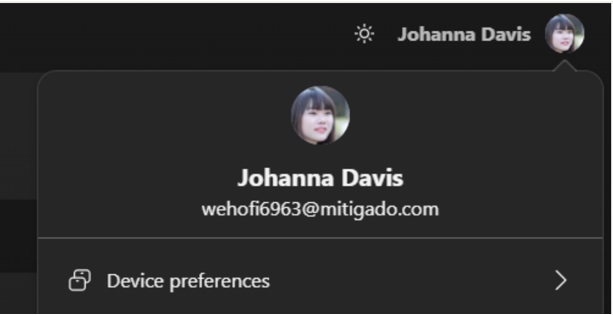- Pagină de pornire
- /
- Articol








Noțiuni introductive despre consola participantului
 În acest articol
În acest articol Feedback?
Feedback?Consola participant este un instrument web care combină serviciul Webex Calling, aplicația Webex sau telefonul de birou cu o interfață desktop pentru a procesa apeluri în interiorul sau în afara organizației. Puteți să filtrați apelurile primite, să gestionați apelurile și persoanele de contact și să monitorizați apelurile dintr-o coadă.
Furnizarea licenței Consolei participant
Consola participant este un client de generație următoare care răspunde nevoilor personalului din recepție și din birou. Un administrator poate configura utilizatori ca operatori telefonici pentru a filtra toate apelurile primite către anumite persoane din cadrul organizației. Furnizați acest client prin intermediul Control Hub-ului.
Consola participant necesită o licență. Utilizați site-ul web Cisco Commerce (CCW) pentru a comanda licențele ca supliment la o comandă Webex Calling sau Webex Suite.
Comandați o licență pentru Consola Operator în următoarele moduri:
-
Cu comanda de achiziție Flex-3
-
Cu o nouă comandă de abonament Webex Calling
-
Modificarea comenzii cu un abonament Webex Calling existent
Cerințe de rețea pentru Consola participant
Consola Webex Attendant este compatibilă cu următoarele sisteme de operare și cerințele minime ale acestora:
| Produs | Configurare |
|---|---|
|
Sistem de operare |
Windows 10 sau o versiune ulterioară |
|
MacOSX 13 sau o versiune ulterioară |
|
|
Procesor |
Patru sau mai multe nuclee fizice |
|
Memorie |
4 GB de RAM sau mai mult |
|
Disc |
Minim 5 GB de spațiu liber pe disc recomandat |
Folosește aceste informații pentru a configura firewall-ul corporativ astfel încât aplicațiile să nu fie blocate.
Port TCP: 443 (HTTPS) pentru toate conexiunile de ieșire.
Domenii și adrese URL pentru consola participantului WebexIată domeniile și subdomeniile de nivel superior pe care le utilizează aplicația:
| Domenii | Descriere | Aplicații care utilizează domeniile / URL-uri |
|---|---|---|
|
imagicle.cloud |
Acces la rețeaua de comunicații în cloud Imagicle |
Aplicația Webex |
|
imagicle.com |
Acces la rețeaua de comunicații în cloud Imagicle |
Aplicația Webex |
|
webexapis.com |
Acces la platforma Cisco Webex, utilizată de microserviciile Webex pentru a gestiona aplicațiile dvs. |
Aplicația Webex |
|
webexcontent.com |
Stocare Webex pentru conținut și jurnalele generate de utilizatori |
Aplicația Webex |
|
login.microsoftonline.com |
Pentru integrarea prezenței și calendarului în echipele MS |
Aplicația Webex |
|
graph.microsoft.com |
Pentru integrarea prezenței și calendarului în echipele MS |
Aplicația Webex |
Iată numele de domeniu complet calificat (FQDN) și adresele IP la care se conectează aplicația Webex în rețeaua Imagicle Cloud:
| FQDN | IP | Regiune acceptată |
|---|---|---|
|
ac.wbx.imagicle.cloud |
(1) |
Toate regiunile |
|
eu.api.imagicle.com |
(1) |
Toate regiunile |
|
actions-eu.console.imagicle.cloud |
18.196.9.252 |
Europa |
|
events-eu.console.imagicle.cloud |
18.195.152.104 |
Europa |
|
us.api.imagicle.com |
(1) |
Statele Unite |
|
actions-us.console.imagicle.cloud |
3.216.35.123 107.21.150.121 |
Statele Unite |
|
events-us.console.imagicle.cloud |
3.216.35.123 107.21.150.121 |
Statele Unite |
|
au.api.imagicle.com |
(1) |
Australia |
|
actions-au.console.imagicle.cloud |
54.253.32.29 52.64.249.210 |
Australia |
|
events-au.console.imagicle.cloud |
54.253.32.29 52.64.249.210 |
Australia |
|
ca.api.imagicle.com |
(1) |
Canada |
|
actions-ca.console.imagicle.cloud |
3.96.230.11 15.156.172.181 |
Canada |
|
events-ca.console.imagicle.cloud |
3.96.230.11 15.156.172.181 |
Canada |
|
uk.api.imagicle.com |
(1) |
Regatul Unit |
|
actions-uk.console.imagicle.cloud |
35.178.34.119 3.11.199.94 |
Regatul Unit |
|
events-uk.console.imagicle.cloud |
35.178.34.119 3.11.199.94 |
Regatul Unit |
|
jp.api.imagicle.com |
(1) |
Japonia |
|
actions-jp.console.imagicle.cloud |
54.65.182.69 54.168.26.80 |
Japonia |
|
events-jp.console.imagicle.cloud |
54.65.182.69 54.168.26.80 |
Japonia |
(1): Acest punct final deservește multe adrese IP, iar adresa se poate schimba.
Începeți o perioadă de probă a consolei Webex Attendant pentru clienții noi
Începeți o perioadă de probă pentru clienții dvs., astfel încât aceștia să poată testa serviciile Webex Attendant Console înainte de a achiziționa un abonament.
Înainte de a începe
Utilizați Hubul pentru parteneri pentru a adăuga, a elimina, a extinde sau a anula versiunile de încercare ale serviciilor pentru clienți și aflați cum să convertiți o versiune de încercare într-o comandă plătită. Consultați Pornirea și gestionarea versiunilor de probă Webex Enterprise în Webex Partner Hub pentru detalii.
| 1 |
Din vizualizarea partenerilor din https://admin.webex.com, accesați Clienți, apoi faceți clic pe Începeți perioada de probă |
| 2 |
Pe pagina Începeți o nouă versiune de încercare , completați numele companiei clientului, adresa de e-mail a administratorului și verticala de afaceri. Dacă nu puteți găsi verticala exactă de afaceri a companiei, selectați următoarea cea mai bună opțiune.
|
| 3 |
Alegeți o țară din țară pentru determinarea listei verticale a regiunii de rezidență a datelor. Aceste informații vă ajută să alegeți regiunea potrivită pentru a stoca datele clientului dvs. Dacă compania are mai multe locații, alegeți-o pe cea cu cei mai mulți utilizatori. Pentru a maximiza experiența utilizatorului și a minimiza latența, stocați datele în centrele de date mai aproape de majoritatea utilizatorilor. Pentru a afla în ce regiune se mapează o țară, consultați Găsirea regiunii localității de date care se mapează la o țară.
|
| 4 |
Confirmați că clientul se află într-o locație acceptată pentru serviciile Webex. Consultați Unde este disponibil Webex? pentru mai multe informații. Când sunteți gata, faceți clic pe Următorul. |
| 5 |
Alegeți următoarele pentru noua versiune de încercare a clientului, apoi faceți clic pe Următorul:
 |
| 6 |
Dacă ați selectat Dispozitive Webex, alegeți dispozitivele pe care doriți să le expediați clientului sau săriți peste acest pas. Poate doriți să săriți în următoarele cazuri:
Puteți procesa o singură expediere pentru fiecare tip de dispozitiv. De exemplu, dacă alegeți să expediați 2 telefoane, nu puteți să vă întoarceți mai târziu și să expediați încă 3 telefoane. Telefoanele nu includ surse de alimentare. Contactați echipa de versiuni de probă Webex Enterprise dacă clientul dvs. nu poate oferi asistență POE. |
| 7 |
Faceți clic pe Salvare , apoi alegeți una dintre următoarele acțiuni:
|
Conectați-vă la consola participantului
Înainte de a începe
-
Consola participant Webex utilizează un cadru de aplicații încorporat pentru a afișa aplicația în Webex. Asigurați-vă că reporniți aplicația pentru a activa aplicația încorporată.
Consultați articolul Aplicații încorporate în Webex pentru pașii necesari pentru setarea comutatorului aplicației încorporate la Activat.
-
Dezactivați ferestrele pop-up Apeluri din aplicația Webex pentru o experiență optimă pentru utilizator.
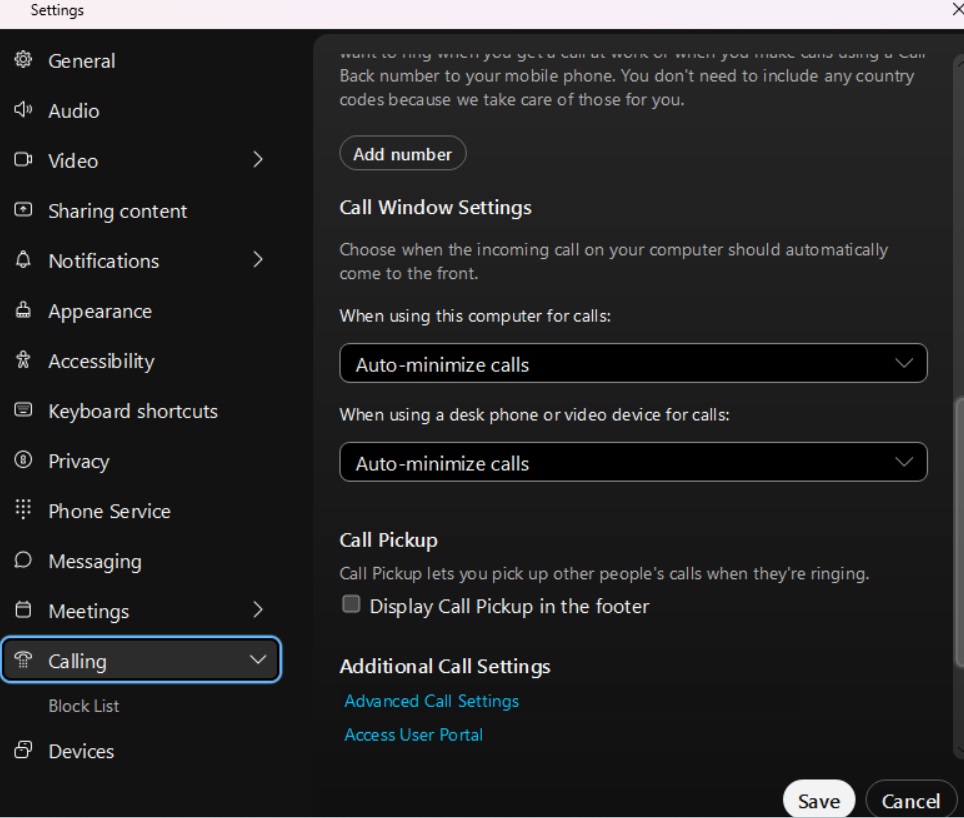
Dezactivați fereastra Apeluri multiple pentru utilizatorii de Windows:
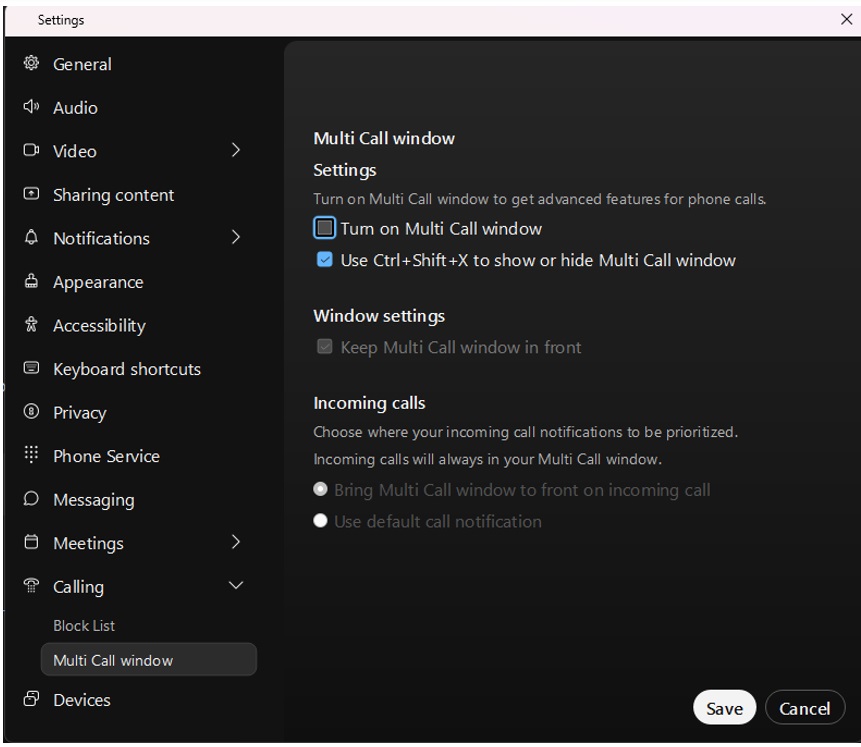
Consola Webex Attendant oferă o interfață de utilizator simplă și intuitivă, fără a necesita procese complexe de instruire. Consultați reprezentarea panourilor principale și funcțiile acestora pentru o prezentare generală inițială a ceea ce găsiți în Consola participant Webex.
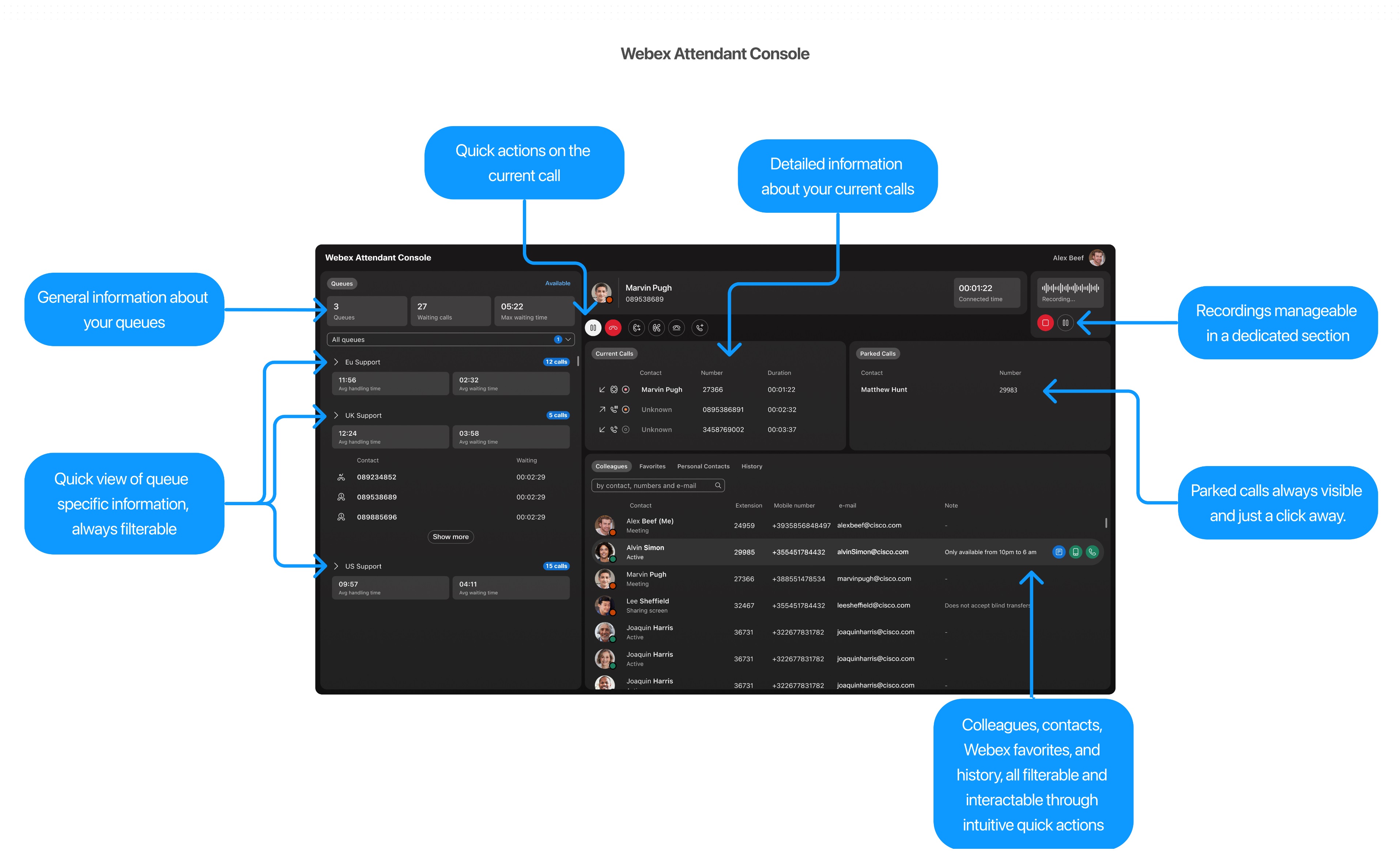
Accesați consola participantului Webex
Aveți nevoie de o aplicație Webex pentru a accesa consola participantului Webex.
-
Deschideți aplicația Webex și faceți clic pe gadgetul WxAC.
Dacă nu vedeți pictograma Gadget WxAC, deconectați-vă și reporniți aplicația Webex.
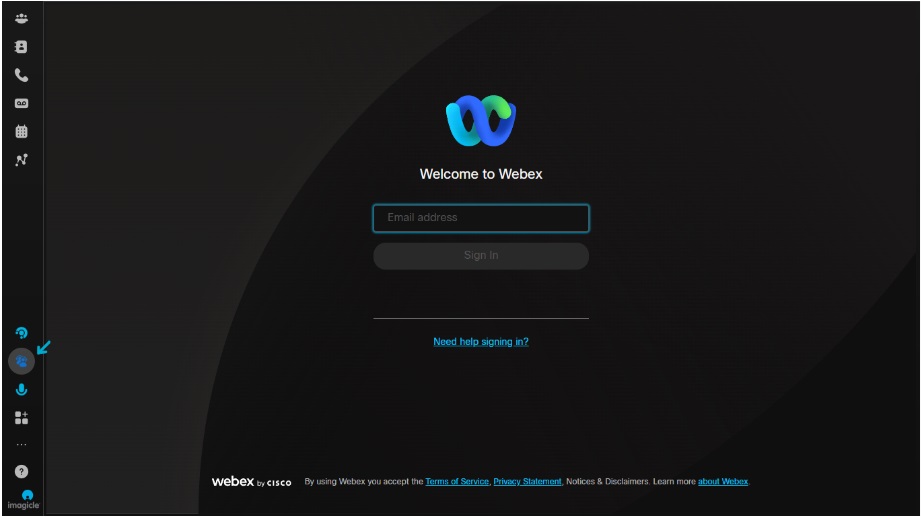
-
Introduceți credențialele.
Dacă organizația dvs. are activată autentificarea unică (SSO), introduceți acreditările și veți fi direcționat către pagina de conectare a furnizorului.
Acceptați următoarele permisiuni pentru consola Webex Attendant la prima conectare:
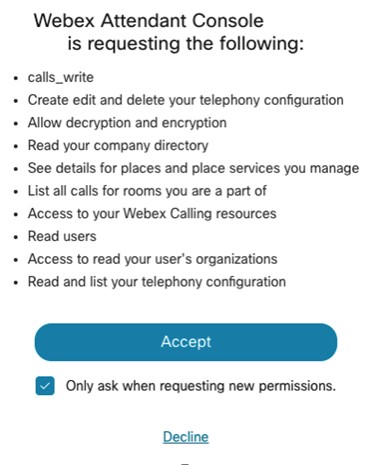
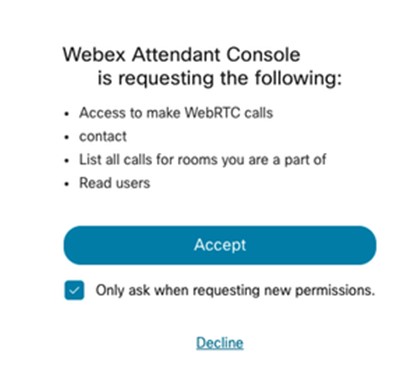
Această permisiune permite consolei participantului Webex să controleze dispozitivul apelant.
Activarea consolei participantului
Puteți atribui manual unui utilizator accesul la Consola participant. Consultați Adăugarea manuală a utilizatorilor în Control Hub pentru detalii.
Puteți edita licența unui utilizator individual pentru a accesa Consola participant. Selectați utilizatorul cu licența Calling Professional, apoi selectați Consola participant. Consultați Editarea licențelor de servicii în Control Hub pentru utilizatori individuali pentru detalii.
Utilizatorul trebuie să aibă o licență Webex Calling Professional pentru a accesa Consola participant.
Din Control Hub, accesați Utilizatorși selectați utilizatorul pentru a activa Consola participant.
Faceți clic pe Apelare și derulați la Experiența utilizatorului în apel > Consola participant pentru a porni Consola participant.
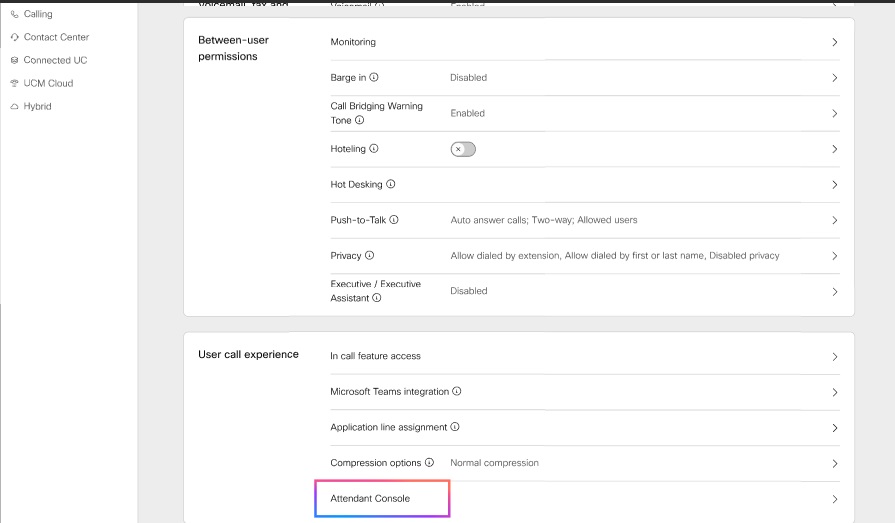
La licențierea unui utilizator pentru Consola participant, administratorul poate utiliza funcțiile Consolei participant.
Pentru a crea o listă de favorite pentru un utilizator, accesați Control Hub, navigați la Services > Apelând > Fila Caracteristici.
Vizualizați consola participantului
Ca administrator, utilizați Consola participant pentru a vizualiza lista utilizatorilor configurați pentru consolă.
- Din Centrul de control, accesați Servicii > Apelând > Caracteristici > Consola participant, selectați Consola participant.
- Alegeți o locație și apoi faceți clic pe OK.
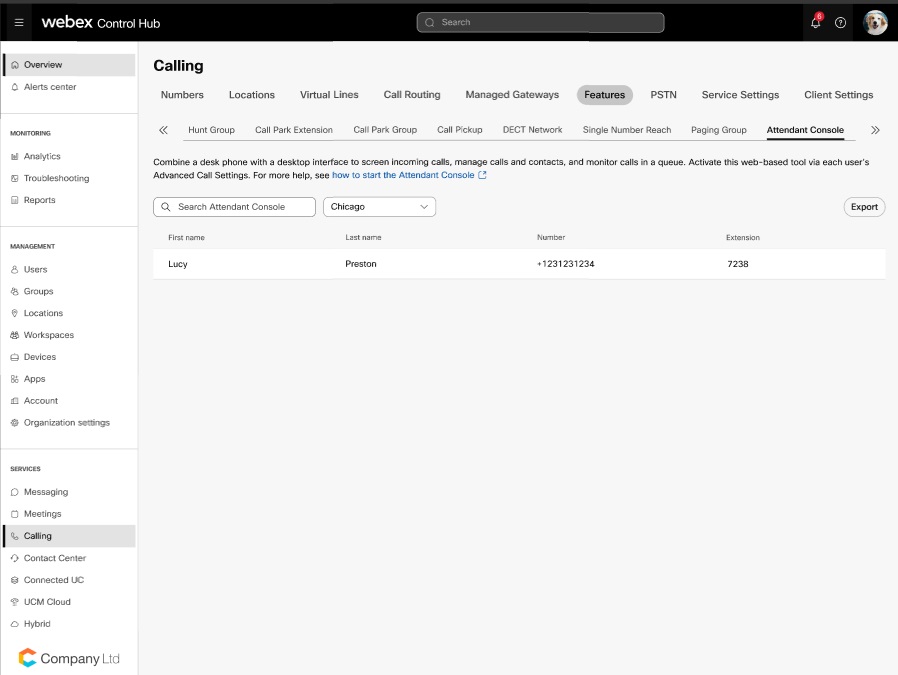
În mod implicit, integrările consolei Webex Attendant sunt activate. Totuși, dacă administratorul clientului a dezactivat App/Integrations, activați App/Integrations utilizând ID-ul de integrare. Din Centrul de control, accesați Administrare>Aplicații și introduceți ID-ul integrării.
- Căutați persoanele sau spațiile de lucru pe care doriți ca acest utilizator să le monitorizeze, apoi faceți clic pe Salvare.
- Vedeți numele și prenumele persoanei desemnate ca recepționer și numărul acesteia de telefon. Faceți clic pe Exportdacă doriți să exportați această listă.
Doriți să cunoașteți și să înțelegeți funcțiile din Consola Webex Attendant? Urmăriți Introducere în Consola Webex Attendant
Experiență pentru utilizatorii existenți ai programului Receptionist Client cu versiunea de probă
Dacă utilizați funcția existentă Receptionist Client și intenționați să migrați la Webex Attendant Console, rețineți aceste indicații:
-
Puteți continua să utilizați funcția Receptionist Client împreună cu abonamentul Attendant Console Trail. Vedeți opțiunea Consola participant în aplicația Webex. În timpul perioadei de probă, fila de funcții pentru Consola participant nu este vizibilă, iar setările existente ale Clientului Recepționist sunt utilizate pentru favorite.
-
La achiziționarea licenței pentru Consola participant, nu mai vedeți Clientul Recepționist și setările de apelare ale utilizatorului în Experiența apelului utilizatorului din Control Hub. Totuși, puteți accesa Clientul Receptionist folosind linkul https://apps.broadcloudpbx.net/receptionist/login/cisco/?authorize=cisco până la sfârșitul perioadei de asistență pentru funcții. Nu se pierd datele de configurare, cum ar fi favoritele.
Pentru organizațiile care nu utilizează Consola Recepționist, nu puteți activa Clientul Recepționist din Control Hub.
Gestionarea contactelor
Căutare rapidă
Funcția de căutare rapidă oferă o abordare simplificată pentru localizarea contactelor în consolă, sporindu-vă productivitatea. Puteți accesa fereastra de Căutare rapidă utilizând oricare dintre aceste acțiuni distincte din cadrul sistemului:
-
Inițiază un apel nou: Inițierea unui apel.
-
Începeți un transfer de consultare: Lansarea unui transfer de consultare.
-
Începeți un transfer orb: Începerea unui transfer orb.
Pentru o prezentare generală, urmăriți 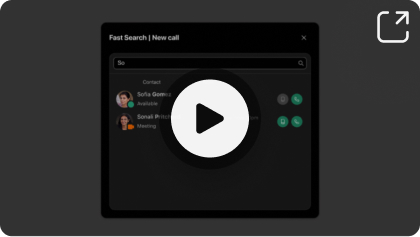
Deschideți fereastra de căutare rapidă pentru a căuta în diverse directoare. Pentru a iniția o căutare, urmați acești pași:
| 1 |
Introduceți interogarea de căutare în câmpul desemnat. Interogările pot include nume, numere de telefon sau adrese de e-mail. |
| 2 |
Apăsați Enter sau faceți clic pe pictograma lupă pentru a căuta. Dacă interogarea nu generează contacte potrivite, se afișează o notificare pentru acestea. Dacă căutarea are succes, rezultatele asociate se afișează sub câmpul de căutare. Contactele personale care corespund interogării dvs. au prioritate față de contactele din alte directoare. |
Fiecare rezultat al căutării se afișează cu următoarele detalii:
-
Avatarul contactului împreună cu starea prezenței sale actuale.
-
Note asociate (dacă sunt disponibile)
-
Butoane de acțiune care variază în funcție de modul în care a fost inițiată fereastra modală de Căutare rapidă. De exemplu, dacă ați accesat fereastra modală prin acțiunea Începeți un apel nou, veți găsi butoane care vă permit să inițiați un apel pentru fiecare contact corespunzător.
Pentru a încărca rezultate suplimentare, derulați în jos folosind mouse-ul.
Dacă sunteți într-un apel și încercați să efectuați un alt apel prin intermediul Panoului de căutare rapidă, apelul curent este pus în așteptare.
Caută în directorul colegului
Fila Coleg este concepută pentru a vă simplifica accesul la informații esențiale despre colegii din cadrul organizației. Puteți recupera rapid și eficient datele de contact, actualizările de prezență, numărul de interior, numărul de telefon mobil și alte informații, cum ar fi adresa de e-mail sau notițele personale de contact.
Vrei să vezi cum se face? Urmărește:
Pentru a naviga prin director, introduceți numele, numărul sau adresa de e-mail a persoanei respective în bara de căutare și faceți clic pe Enter sau pe pictograma de căutare.
Utilizați fila Colegi pentru a căuta toți utilizatorii din Control Hub și nu doar utilizatorii Webex Calling. Puteți filtra utilizatorii după o anumită locație sau un anumit grup.
Plasarea cursorului peste un contact dezvăluie acțiuni specifice, cum ar fi:
-
Adăugați în favorite
-
Adăugarea sau editarea unei note
-
Apelarea numărului de telefon mobil
-
Apelarea extensiei
De asemenea, puteți găsi o descriere a stării prezenței contactului. Dacă este configurată, această descriere include atât prezența Webex, cât și cea a echipei Microsoft.
Căutați în directorul de favorite
Consola Webex Attendant permite gestionarea a două tipuri de contacte din Favorite:
-
Favorite autogestionate - gestionate de fiecare recepționer personal
-
Favorite gestionate de administrator - gestionate de un administrator pentru recepționerul specific
Vrei să vezi cum se face? Urmărește:
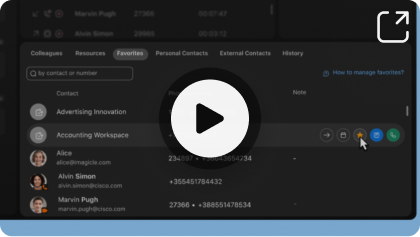
Favorite autogestionate
Aceste favorite sunt flexibile, deoarece utilizatorii recepționerului pot adăuga și elimina contacte.
Pentru a adăuga un contact nou în fila Favorite, faceți clic pe pictograma stea de lângă contactul respectiv din fila Colegi sau din fila Resurse.
Puteți căuta contactele favorite, puteți vedea informațiile despre prezența lor și puteți apela numerele asociate.
Pentru a elimina un contact din Favorite, faceți clic pe pictograma stea de lângă contactul respectiv în fila Favorite sau din filele Colegi și Resurse.
Favorite gestionate de administrator
Doar administratorii pot adăuga, șterge și gestiona aceste favorite, în timp ce recepționerii pot vedea contactele listate în fila Favorite.
Doar administratorii pot adăuga și gestiona contactele din lista de favorite folosind Control Hub, urmând acești pași:
| 1 |
Conectați-vă la Control Hub. Navigați la Utilizatori> Management.
|
| 2 |
Selectați utilizatorul recepționerului pentru care doriți să configurați favoritele. |
| 3 |
Faceți clic pe Apelare și derulați la Experiență apel utilizator, faceți clic pe Consolă participant. |
| 4 |
Introduceți numele și numărul contactului favorit în câmpul de căutare.
|
| 5 |
Puteți alege să Adăugați sau Ștergeți o favorită. |
| 6 |
Faceți clic pe Salvați. |
Căutați folosind contactele din Resurse
Folosește fila Resurse pentru a căuta în următoarele resurse Webex Calling:
Vrei să vezi cum se face? Urmărește:
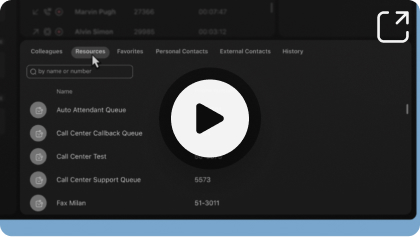
-
Cozi de apeluri în așteptare
-
Grupuri de vânătoare
-
Operatori automați
-
Spații de lucru
-
Extensii virtuale
-
Linii virtuale
Puteți adăuga contacte de resurse la favorite.
Telefonul și prezența complexă nu sunt disponibile pentru resurse.
Căutare folosind contacte externe
Utilizați fila Contacte externe pentru a căuta contactele corporative Control Hub ca o agendă centralizată.
Vrei să vezi cum se face? Urmărește:
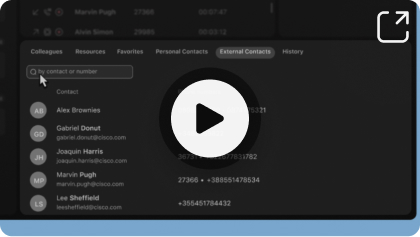
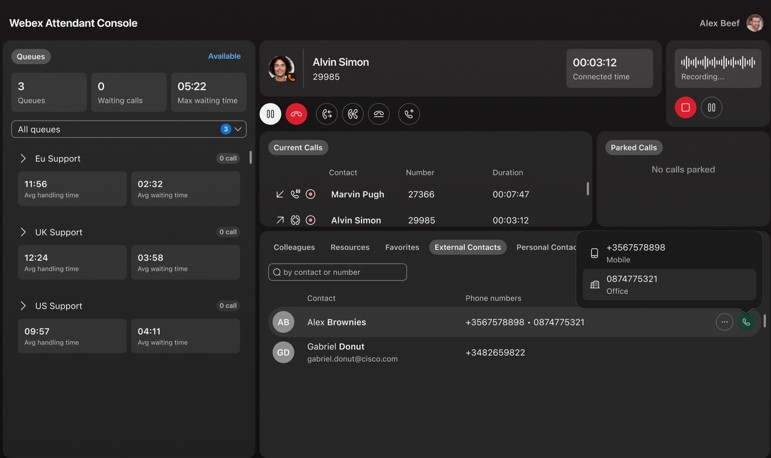
Sursele de contacte pot fi:
-
Local (încărcat manual în Control Hub)
-
BroadWorks
-
Protocolul ușor de acces la director (LDAP)
-
Cisco Unified Communications Manager
Gestionați directorul personal
Puteți adăuga persoane de contact care nu fac parte din organizația dvs. urmând acești pași:
Vrei să vezi cum se face? Urmărește:
-
Folosește fila Contacte personale și apoi dă clic pe Creare.
-
Introduceți numele și numărul de telefon al persoanei pe care doriți să o adăugați și faceți clic pe Confirmare.
-
Puteți edita, șterge și efectua apeluri către contactele pe care le-ați creat. Plasați cursorul peste rândul din tabelul de contacte și faceți clic pe butonul corespunzător acțiunii dorite.
La adăugarea contactelor personale, aceleași contacte apar în lista de contacte din aplicația Webex și invers.
Pentru o prezentare generală, consultați Utilizarea directorului personal.
Adăugați o notă
Folosește Consola participant pentru a adăuga note colegilor și contactelor favorite. Plasați cursorul peste rândul de contact și alegeți contactul, apoi faceți clic pe opțiunea Adăugați o notă.
Notele sunt private și au o limită de 255 de caractere.
Taburi personalizabile
Gestionați-vă contactele folosind filele personalizabile
Funcția File personalizabile introduce o modalitate flexibilă și orientată către utilizator de a organiza contactele în consola Webex Attendant. Vă permite să definiți, să redenumiți, să reordonați și să atribuiți contacte file în funcție de fluxurile de lucru personale sau de nevoile organizaționale.
Fereastra pop-up de gestionare a filelor este accesibilă din colțul din dreapta al interfeței panoului de contact. Faceți clic pe noua pictogramă pentru a deschide un meniu unde puteți:
-
Afișați sau ascundeți filele existente folosind casetele de selectare.
-
Adăugați noi file personalizate după nume.
-
Reordonați filele prin drag-and-drop în fereastra pop-up.
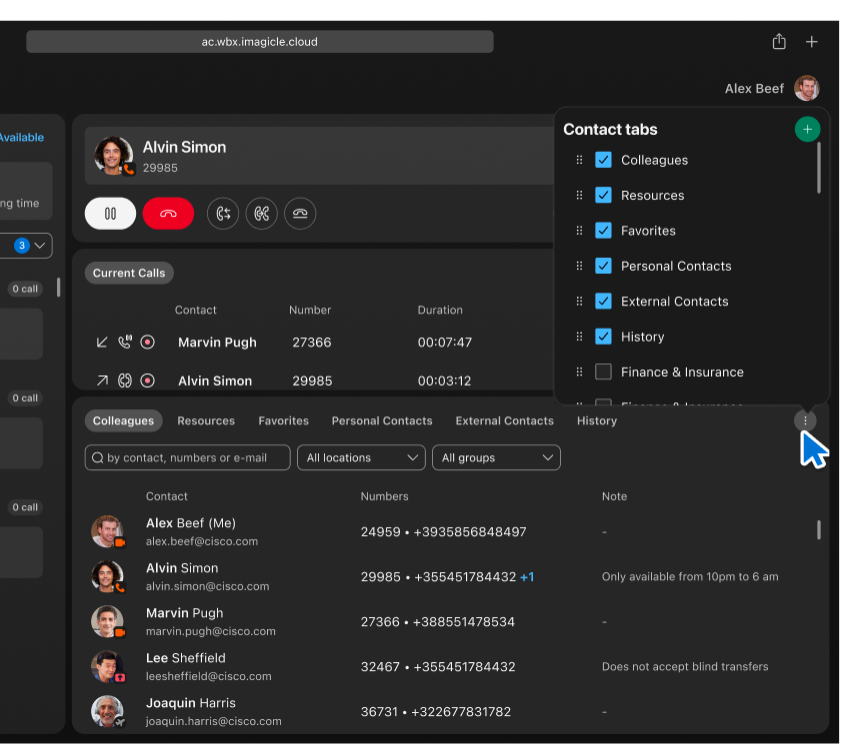
Această interfață vă oferă control complet asupra aspectului contactelor, oferind suport pentru diverse cazuri de utilizare, de la separarea departamentelor până la prioritizarea contactelor.
Crearea și organizarea filelor personalizate
Puteți crea file noi, cum ar fi Finanțe & Asigurări, Servicii & Întreținereși Piese & Inventar care apar alături de cele implicite (cum ar fi: Colegi și Favorite), ceea ce face navigarea mai clară și mai intuitivă.
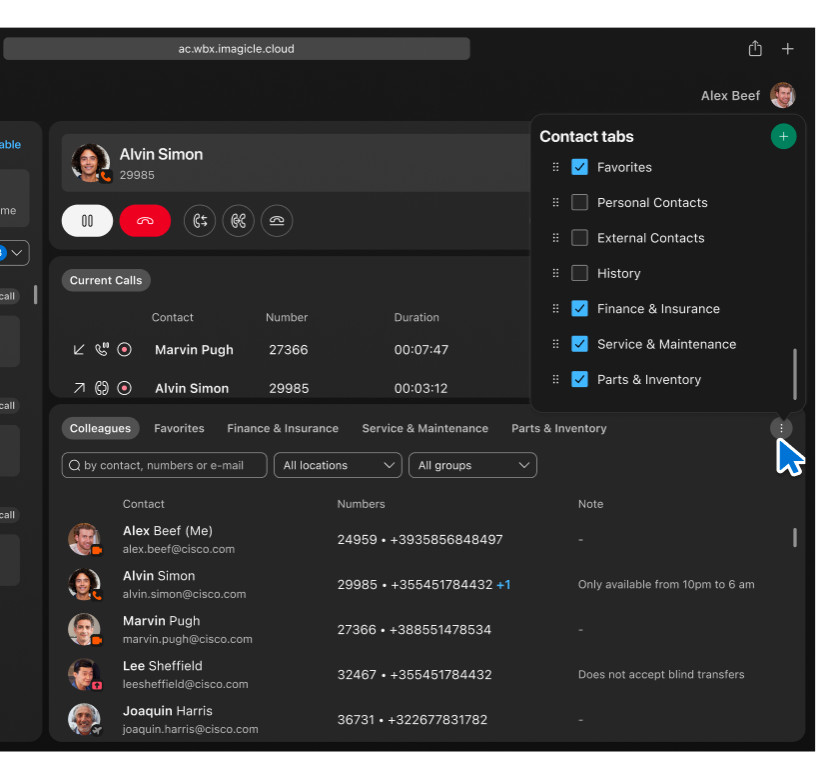
Puteți comuta vizibilitatea acestor file oricând folosind același meniu.
Atribuirea contactelor la file
Puteți atribui un contact uneia sau mai multor file. Când faceți clic pe pictograma stea sau pe meniul contextual al unui contact, apare o fereastră pop-up care permite atribuirea mai multor tab-uri prin intermediul casetelor de selectare.
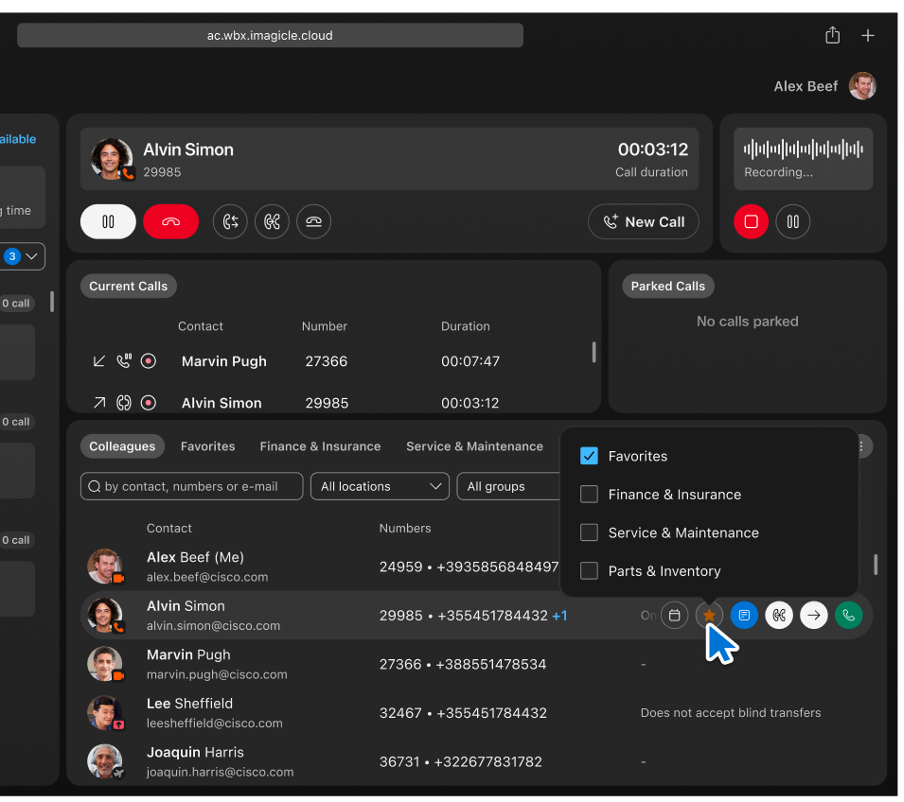
Beneficii:
-
Personalizare completă—Definiți câte file este necesar pentru orice flux de lucru.
-
Gestionare din mers—Adăugați sau atribuiți contacte în timpul operațiunilor în timp real.
-
Claritate vizuală—Puteți vedea clar toate filele și puteți comuta cu ușurință între ele.
-
Scalabilitate—Ideal pentru utilizatorii care gestionează mai multe departamente, clienți sau regiuni.
Gestionarea apelurilor
Apel de la tastatură
Puteți apela utilizând fila Colegi, Favorite, Contacte personale sau Istoric. Derulați la contact și la evidențierea contactului, permițându-vă să efectuați un apel.
Pentru a efectua un apel de la tastatură.
| 1 |
Introduceți un număr valid și apăsați Enter pe tastatură sau faceți clic pe butonul Apel. |
| 2 |
Alternativ, faceți clic pe pictograma Receptor telefonic pentru a efectua o căutare rapidă și a apela un contact memorat. Pentru a apela direct fără a primi și a răspunde la un apel primit, setați Dispozitiv preferat în preferințele dispozitivului. |
Apel din căutarea rapidă
Funcționalitatea Inițiază apel nou oferă o modalitate rapidă și eficientă de inițiere a apelurilor prin intermediul modalului Căutare rapidă. Această funcție simplifică procesul de a contacta contactele tale. Pentru a începe, urmați acești pași:
| 1 |
Faceți clic pe butonul Inițiați un apel nou. Panoul Căutare rapidă afișează o funcție care simplifică procesul de inițiere a apelului. |
| 2 |
În panoul Căutare rapidă, introduceți criteriile de căutare pentru a localiza contactul dorit. Puteți căuta după nume, număr de telefon sau interior. |
| 3 |
Identificați contactul pe care doriți să îl apelați, selectați unul dintre numerele de contact disponibile, cum ar fi mobil, telefon sau interior. |
| 4 |
Faceți clic pe butonul Apel asociat cu numărul de contact ales pentru a iniția apelul. |
Gestionează apelul
Primește un apel
Pentru a răspunde la un apel, faceți clic pe butonul Preluare apel de pe tastatură sau utilizați panoul Apeluri curente. De asemenea, asigură-te că selectezi un dispozitiv preferat în preferințele dispozitivului.
Hold / Cv
Folosește tasta /Resume pentru a controla apelurile active, permițându-vă să întrerupeți și să reluați conversația.
-
Punerea unui apel în așteptare—Pentru a pune un apel activ în așteptare, faceți clic pe butonul Așteptare. Această acțiune întrerupe apelul, iar pictograma de stare de lângă intrarea apelului din panoul Apeluri curente se actualizează.
-
Reluare apel în așteptare—Pentru a relua apelul din prim-plan care este în așteptare în prezent, faceți clic pe butonul Reluare. Această acțiune reia apelul pus în așteptare, permițându-vă să continuați conversația.
Puteți relua un apel din panoul Apeluri curente. Faceți dublu clic pe apel sau faceți clic pe butonul Reluare care apare la trecerea cu mouse-ul peste apel.
Transferați un apel
Utilizați una dintre aceste metode în consola participantului Webex pentru a transfera un apel conectat:
-
Transfer orb
-
Transfer supravegheat
-
Transfer rapid
Transfer orb
Transferul orb, denumit și transfer nesupravegheat sau transfer rece, redirecționează un apel conectat către o nouă destinație fără nicio consultare prealabilă cu destinatarul. Folosiți această metodă pentru a transfera un apel către un alt agent, un alt departament sau o persoană de contact externă.
Pentru a iniția un Transfer Orb, urmați acești pași:
-
Faceți clic pe butonul Start orb transfer situat sub tastatură.
-
Se afișează panoul Căutare rapidă. Folosește-l pentru a localiza contactul.
-
Selectați dacă doriți să transferați apelul către interiorul sau numărul de telefon mobil al contactului și finalizați Transferul Orb.
Pentru o prezentare generală, vizionați Transfer fără veste.
Transfer supravegheat
Transferul supravegheat, cunoscut și sub denumirea de transfer cald sau consultativ, vă permite să consultați destinatarul înainte de a finaliza transferul apelului.
Pentru a iniția un transfer supravegheat, urmați acești pași:
-
Faceți clic pe butonul Începeți transferul consultării.
-
Căutați persoana de contact pe care doriți să o consultați și faceți clic pe butonul corespunzător pentru a iniția consultarea.
-
După consultări, faceți clic pe Finalizare transfer pentru a încheia transferul.
Pentru o prezentare generală, consultați Transfer supravegheat.
Transfer rapid
Consola participantului Webex permite transferul rapid al unui apel către o destinație relativă. Selectați destinația relativă din orice panou de contacte, Colegi, Favorite, Contact personal sau Istoric apeluri.
Această funcție oferă o modalitate convenabilă de a transfera apelurile către destinațiile utilizate frecvent.
Pentru a iniția un transfer rapid în timpul unui apel activ, utilizați Transfer orbsau Începere transfer consultare și transferați apelul către un număr de interior sau un număr de telefon mobil. Selectați butonul de acțiune de pe contactul relativ.
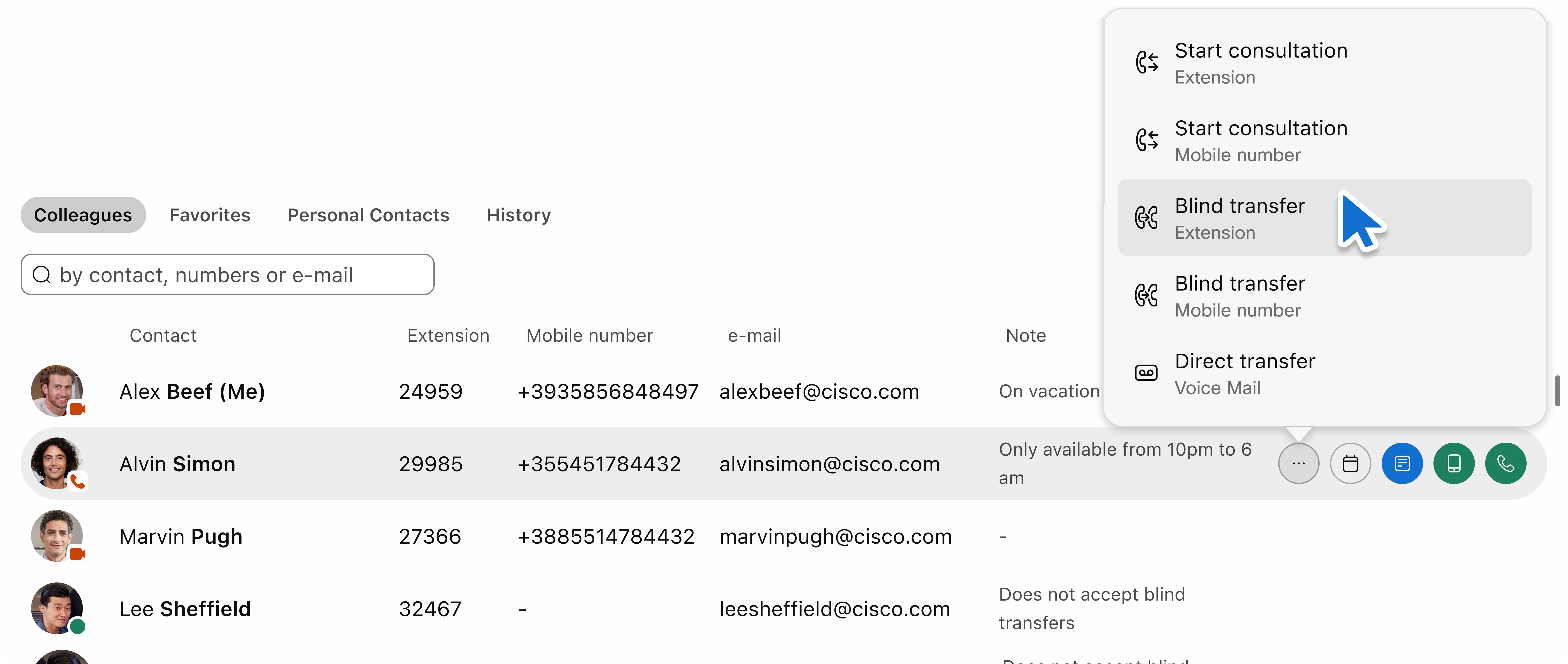
Transferare apel la mesagerie vocală
Uneori, este necesar să direcționezi un apel către mesageria vocală a destinatarului, mai ales când acesta nu este disponibil sau în afara orelor de program.
-
Pentru a iniția un transfer către mesageria vocală, accesați panoul Căutare rapidă.
-
Faceți clic pe butonul Transfer către mesageria vocală pentru a redirecționa apelul către mesageria vocală a contactului selectat.
Transfer cu un singur clic
Funcția Transfer cu un singur clic simplifică transferul apelurilor active cu o interacțiune minimă din partea utilizatorului. Butoanele contextuale plasate lângă fiecare contact vă permit să inițiați un transfer cu o singură acțiune.
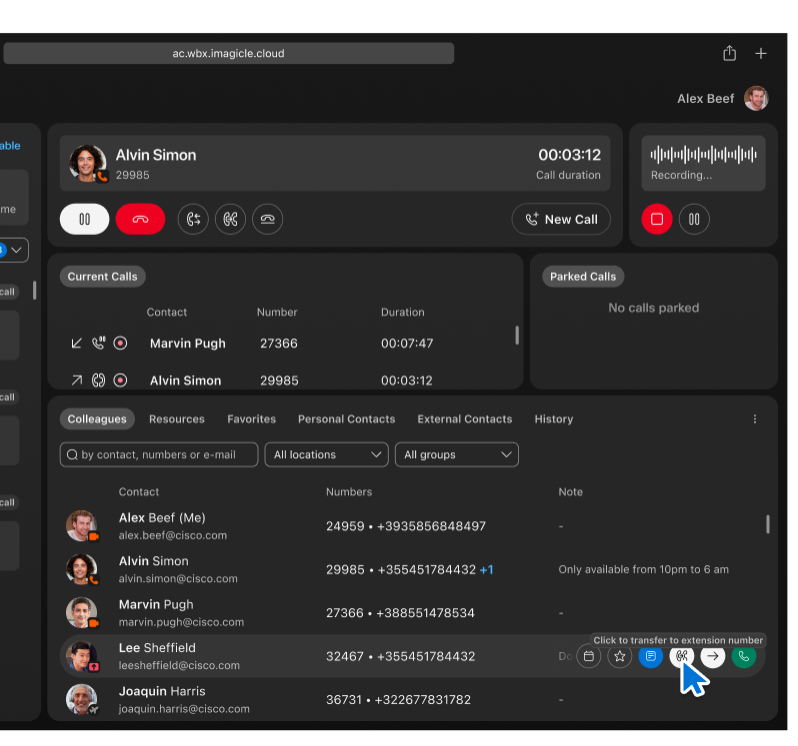
Când un apel activ este în desfășurare în consola participantului Webex, pictogramele de acțiune apar lângă fiecare contact. În captura de ecran anterioară, puteți vedea cum apare funcția în timpul unui apel în desfășurare, cu acțiuni contextuale afișate pentru fiecare contact. Când treceți cu mouse-ul peste pictograma de transfer pentru Lee Sheffield, aceasta declanșează o informație suplimentară și permite transferul instantaneu al apelului curent către extensia principală a lui Lee.
Butonul evidențiat transferă apelul către numărul intern al contactului cu un singur clic. Nu trebuie să deschideți dialoguri sau să tastați manual nimic. Pictogramele sunt sensibile la context și afișează sfaturi instrumentale la trecerea cursorului pentru claritate, cum ar fi Faceți clic pentru a transfera la numărul de extensie.
Beneficii:
-
Viteză—Acțiune imediată fără pași suplimentari în interfața cu utilizatorul.
-
Claritate— Plasarea vizuală lângă numele contactelor asigură o descoperire și o utilizare ușoară.
-
Ușurință în utilizare—Conceput pentru medii cu trafic intens, cum ar fi recepțiile sau centrele de dispecerat apeluri.
Această funcție funcționează în toate vizualizările de contacte vizibile, inclusiv Favorite, Tab-uri și rezultatele căutării, asigurând performanțe consecvente în întreaga interfață.
Vizualizați apelurile curente
Puteți accesa panoul Apeluri curente din secțiunea tastatură, lângă secțiunea Apel parcat. Afișează starea apelurilor în curs. Dacă nu există apeluri curente, se afișează mesajul Niciun apel în curs.
Fiecare intrare de apel oferă următoarele informații:
-
Direcție: Afișează apelurile primite sau efectuate cu pictogramele corespunzătoare și text alternativ.
-
Stat: Afișează apelurile care sună, în pauză sau conectate cu pictogramele și textul alternativ corespunzătoare.
-
Contactați- ne Name/Surname: Afișează numele real pentru colegi și contactele personale. Pentru numerele externe nerecunoscute, se afișează ca Utilizator necunoscut.
-
Număr de telefon
-
Durată : Afișează durata apelului de la evenimentul de origine pentru apelurile de formare până la evenimentul de răspuns pentru apelurile conectate.
Dacă numele sau linia unui contact este lungă, aceasta este trunchiată cu puncte de suspensie. Plasarea cursorului deasupra acestuia dezvăluie numele complet.
În panoul Apeluri curente, puteți gestiona apelurile în curs în următoarele moduri:
-
Răspunsul la un apel: Puteți răspunde la un apel primit făcând clic pe pictograma de răspuns.
-
Respingerea unui apel: Dacă doriți să refuzați un apel primit, faceți clic pe pictograma pentru retragerea apelului.
-
Apel în așteptare: Pentru a pune temporar în așteptare un apel conectat, faceți clic pe pictograma de așteptare.
-
Reluarea unui apel: Dacă ați întrerupt un apel, îl puteți relua fie făcând dublu clic pe apel, fie făcând clic pe pictograma de reluare.
-
Închiderea unui apel: Pentru a încheia un apel, faceți clic pe pictograma de închidere.
-
Gestionarea erorilor: Dacă există erori operaționale, apare o fereastră generică de eroare pentru a oferi îndrumări suplimentare.
De asemenea, iată câteva caracteristici ale panoului Apeluri curente:
-
Apelurile din cadrul panoului sunt sortate automat în funcție de ora lor de începere. Acest lucru asigură că cele mai noi apeluri sunt poziționate în partea de sus.
-
Dacă există mai mult de trei apeluri în panou, apare o bară de derulare, permițându-vă să navigați prin listă.
-
Istoricul apelurilor de acces
Panoul Istoric apeluri conține o listă de apeluri primite, efectuate și pierdute. Afișează maximum 60 de înregistrări, cu un maxim de 20 de înregistrări pentru fiecare tip de apel.
Lista are patru coloane: Direcții, nume de contact, număr, dată și oră. Inițial este sortată crescător după dată, dar puteți sorta lista în funcție de fiecare coloană.
Pentru a iniția un apel, treceți cu mouse-ul peste fiecare rând pentru a accesa pictograma Efectuați un apel. Când se termină un apel sau are loc un nou eveniment de apel, istoricul apelurilor se actualizează automat.
Setați un dispozitiv de apelare preferat
Alegeți dispozitivul preferat pentru a gestiona apelurile în consola participantului Webex, fie că este vorba de telefonul de la birou, fie de aplicația Webex.
Urmați acești pași pentru a accesa setările Dispozitiv preferat :
| 1 |
Accesează-ți profilul: Conectați-vă la Consola participantului, localizați pictograma profilului sau avatarul în secțiunea de antet a aplicației.
Dacă nu ți-ai setat încă dispozitivul preferat și ai mai multe dispozitive, vei observa o insignă de avertizare pe pictograma avatarului tău. |
| 2 |
Selectați dispozitivul preferat: Din fereastra pop-up pentru avatar care apare, selectați opțiunea Dispozitiv preferat. Această acțiune deschide acordeonul unde vedeți lista dispozitivelor disponibile.
|
Începeți un apel de conferință
Folosește funcția Apel conferință pentru a îmbina apelurile, permițând participarea a doi sau mai mulți participanți la o conversație unificată.
Urmați acești pași pentru a iniția o conferință telefonică:
| 1 |
Inițiază primul apel- Apelează unul dintre participanți. |
| 2 |
Inițiați al doilea apel- Apelați al doilea participant, iar primul participant este pus automat în așteptare. 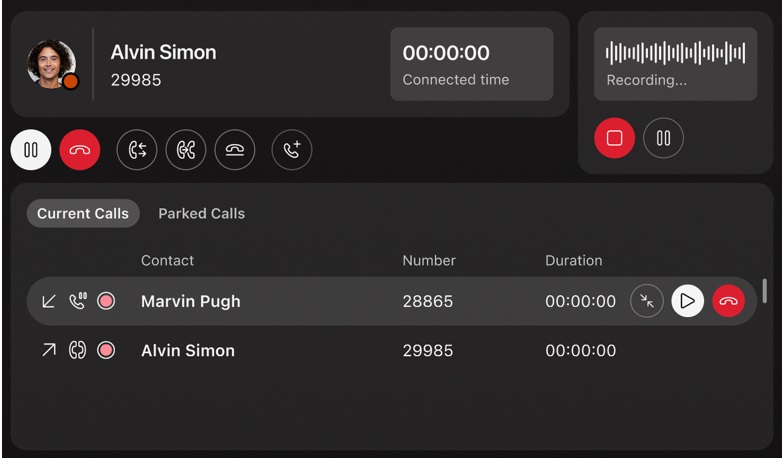 |
| 3 |
Îmbinarea apelurilor într-o conferință |
| 4 |
Gestionarea conferinței și a participanților
|
Parchează un apel
Funcția de parcare a apelurilor oferă o alternativă la plasarea apelurilor în așteptare, cu avantajul de a îmbunătăți capacitățile de gestionare a apelurilor:
-
Parcare apeluri multiple: Spre deosebire de modul tradițional de așteptare a apelurilor, puteți parca mai multe apeluri simultan, facilitând gestionarea mai multor conversații.
-
Vizibilitate partajată: La parcarea unui apel, acesta devine vizibil și accesibil oricărei persoane care aparține aceluiași grup de parcare. Acest lucru permite o colaborare fără probleme și garantează că niciun apel nu este lăsat nepreluat.
Configurați o parcare de apeluri
Activați funcția de parcare apeluri pentru utilizator, fie direct (pentru o persoană), fie ca grup, pentru a atribui utilizatorul în Consola participant. Folosește Parcarea de grup pentru a partaja vizibilitatea între recepționer și utilizatori și pentru a gestiona parcarea apelurilor.
Configurați Parcarea de grup pentru locația utilizatorilor recepționerului, cu membrii ca destinație de parcare. Setați steagul Folosește membri ca destinație a parcării. Adăugați toți recepționerii locației ca membri. Puteți adăuga mai mulți utilizatori la Parcarea de grup, pentru a permite un număr mai mare de apeluri parcate simultan.
Asigurați-vă că fiecare utilizator din interiorul unei parcări de grup are un număr de interior.
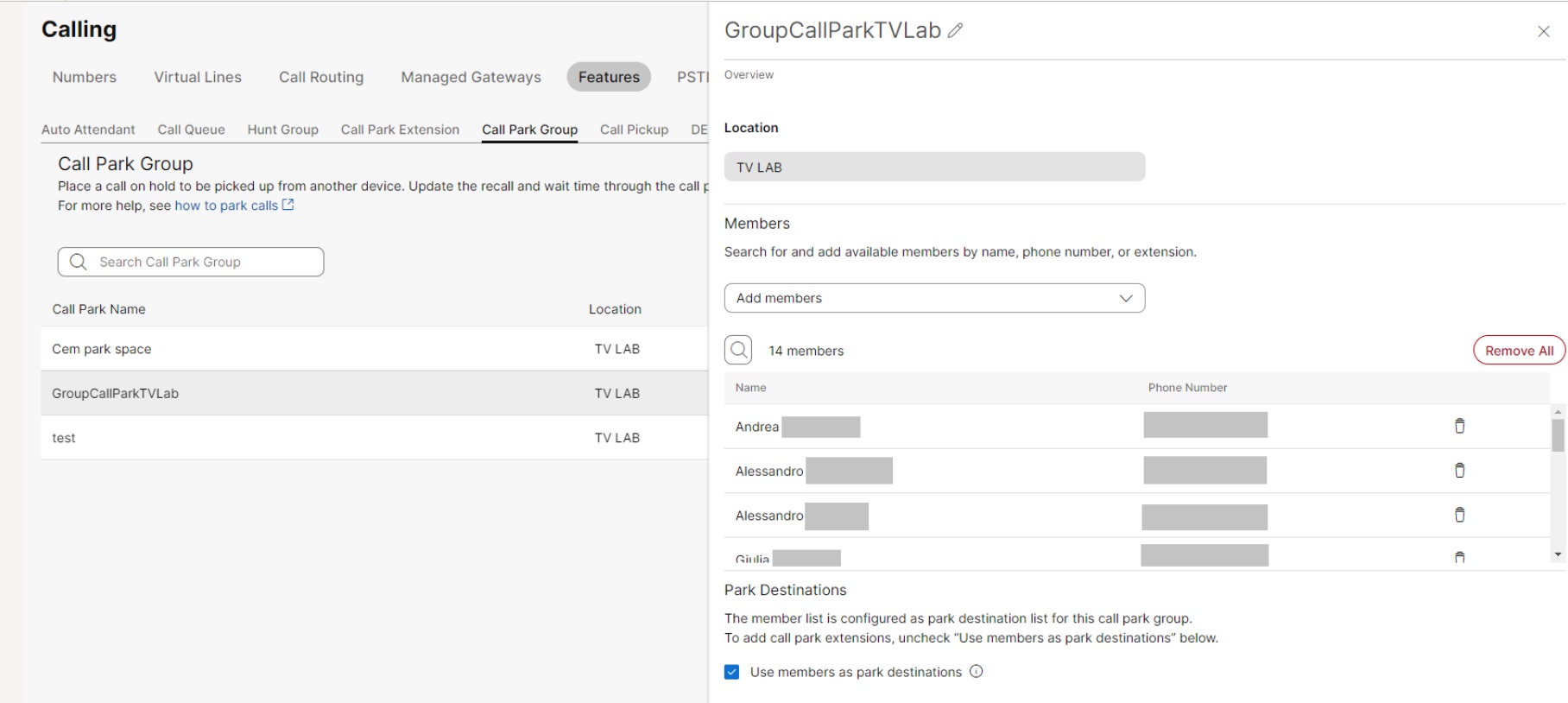
Pentru a parca un apel activ aflat în prim-plan, faceți clic pe butonul Parcați apelul. Această acțiune parchează instantaneu apelul în grupul de parcare desemnat.
Odată parcat, apelul devine vizibil în panoul Apeluri parcate și este accesibil tuturor membrilor grupului de parcare. Orice utilizator autorizat poate apoi prelua apelul parcării, asigurând o gestionare eficientă a apelurilor și colaborarea în cadrul echipei.
Accesați panoul de coadă
Dacă contul dvs. este autorizat să vizualizeze cozile, veți observa un panou situat în partea stângă a interfeței aplicației. În acest panou, puteți vedea cozile la care sunteți abonat și puteți vizualiza și statisticile.
În partea de sus a panoului, găsiți trei casete informative care vă oferă o prezentare generală a statisticilor legate de cozi. Aceste statistici includ:
-
Cozi de abonament: Acest câmp afișează numărul total de cozi la care sunteți abonat.
-
Apeluri curente în așteptare: Acest câmp afișează numărul în timp real al apelurilor aflate în așteptare în cozi.
Utilizatorul trebuie să activeze Apel în așteptare astfel încât apelurile să apară în secțiunea Apeluri curente a consolei participant.
-
Timp maxim de așteptare: Această metrică reprezintă cel mai lung timp de așteptare pe care un apel l-a avut în coadă.
Filtrare cozi
Pentru a simplifica vizualizarea și a vă concentra pe cozile care vă interesează, utilizați meniul derulant Toate cozile. Această opțiune vă permite să filtrați și să afișați doar cozile care corespund nevoilor dvs. actuale, ascunzându-le în același timp pe cele mai puțin relevante.
În prezent, nu este posibil să vă schimbați statutul agentului sau să vă dezabonați de la o coadă direct din consola Attendant. Pentru a înceta să mai primiți apeluri de la anumite cozi, trebuie să vă dezabonați de la aplicația Webex.
Statistici specifice cozii
Fiecare coadă este echipată cu statistici dedicate, care includ:
-
Timp mediu de manipulare: Această metrică cuantifică durata tipică de care are nevoie un agent pentru a gestiona un apel din momentul în care acesta intră în coadă.
-
Timp mediu de așteptare: Timpul mediu de așteptare reprezintă perioada tipică petrecută de un apelant într-o coadă înainte ca un agent disponibil să îi preia apelul.
Vizualizați conținutul cozii
Pentru a vizualiza apelurile curente dintr-o anumită coadă, puteți extinde panoul făcând clic pe acesta. Pentru a-l readuce la starea inițială, pur și simplu faceți clic din nou pe el.
Vrei să vezi cum se face? Urmărește Accesează panoul Coadă și vizualizează Statistici.
Utilizarea vizualizării compacte
Vizualizarea compactă reduce spațiile goale, înălțimea rândurilor din tabel, dimensiunea pictogramelor și dimensiunea fontului. Astfel, se afișează mai multe informații în fereastra aplicației.
Apăsați pictograma Avatar personal din colțul din dreapta sus al aplicației pentru a activa sau dezactiva opțiunea Vizualizare compactă.
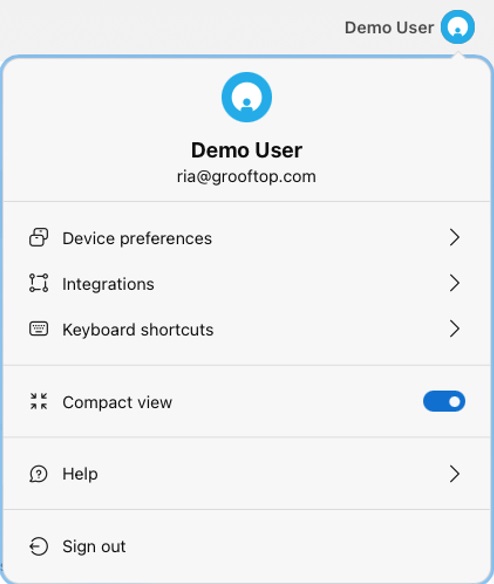
Înregistrare apel
Opțiunea de înregistrare a apelurilor permite utilizatorilor să salveze înregistrări audio ale apelurilor lor. Această funcție este utilă pentru documentarea conversațiilor, arhivarea informațiilor importante și asigurarea unei înregistrări fiabile a comunicării pentru referințe ulterioare. Oferă un instrument valoros pentru menținerea unor evidențe precise și este benefic în contexte profesionale sau juridice în care documentația este esențială.
De asemenea, anumite butoane din secțiunea Înregistrare apeluri sunt dezactivate în funcție de setările de configurare ale utilizatorului din Control Hub. Acest lucru asigură că funcționalitatea se aliniază cu permisiunile și setările specifice ale utilizatorului. Administratorul configurează permisiunile de înregistrare a apelurilor pentru un utilizator.
Utilizator fără serviciu de înregistrare activat
Pentru utilizatorii care nu au serviciul de înregistrare activat, panoul de înregistrare nu este afișat.
Utilizator cu serviciul de înregistrare activat
Când nu există apeluri în desfășurare, toate butoanele panoului de înregistrare sunt dezactivate, iar animația de înregistrare în desfășurare nu este vizibilă.
Pentru utilizatorii care au serviciul de înregistrare activat, se aplică următoarele scenarii în funcție de configurația de înregistrare a utilizatorului:
-
Mod de înregistrare: Mereu activat— Utilizatori cu modul de înregistrare : Configurația Always On experimentează inițierea automată a înregistrării în timpul apelurilor primite și efectuate. Butonul Stop este vizibil, dar dezactivat.
-
Mod de înregistrare: Mereu activ cu Pause/Resume—Pentru utilizatorii cu modul de înregistrare : Mereu activ cu Pause/Resume configurație, atât apelurile primite, cât și cele efectuate declanșează inițierea automată a înregistrării. Butonul Stop este vizibil, dar rămâne dezactivat.
În cazul în care utilizatorul optează pentru întreruperea înregistrării în timp ce aceasta este în desfășurare, aceasta se oprește temporar și butonul Reluare devine vizibil.
Dacă întrerupeți în mod deliberat o înregistrare, reluarea acesteia duce la reluarea înregistrării.
-
Mod de înregistrare: La cerere—Pentru utilizatorii cu modul de înregistrare: În configurația La Cerere, nici apelurile primite, nici cele efectuate nu declanșează inițierea automată a înregistrării. Apăsați butonul Record pentru a începe procesul de înregistrare și Stop/Pause Butonul este atât vizibil, cât și funcțional.
-
Când un utilizator reia un apel întrerupt, panoul de înregistrare afișează starea de înregistrare a apelului reluat.
-
Când înregistrați un apel, o pictogramă de înregistrare este afișată în panoul Apeluri active.
-
Când apare o eroare, se afișează o casetă de dialog cu un mesaj de eroare.
Utilizarea scurtăturilor de la tastatură
Consola WebexAttendant vă permite să executați acțiuni folosind comenzile rapide de la tastatură. Această funcție oferă confortul efectuării sarcinilor cu o simplă apăsare de tastă.
Răspunsul la un apel
Pentru a răspunde la un apel primit, apăsați Alt + Un.
Accesarea comenzilor rapide de la tastatură disponibile
Pentru a accesa lista de comenzi rapide de la tastatură disponibile, urmați acești pași:
-
Faceți clic pe Avatarul profilului din colțul din dreapta sus al interfeței aplicației. Această acțiune deschide meniul utilizatorului.
-
În meniul utilizator, localizați și faceți clic pe Comenzi rapide de la tastatură pentru a vizualiza lista comenzilor rapide disponibile.
Stăpânirea acestor scurtături de la tastatură ajută la navigare și la efectuarea acțiunilor cu o eficiență remarcabilă, îmbunătățind experiența generală a utilizatorului.
Integrare cu aplicațiile Microsoft
Consola participant permite integrarea cu platformele Microsoft, asigurându-vă că aveți toate informațiile esențiale pentru gestionarea apelurilor. Puteți activa aceste două integrări:
-
Integrare MS Teams Presence
-
Integrare Office 365
Urmați acești pași pentru a accesa setările de integrare:
| 1 |
Accesează-ți profilul: Conectați-vă la Consola participant, localizați pictograma profilului sau avatarul în secțiunea de antet a aplicației. Dacă te-ai conectat anterior la integrarea Microsoft și datele de conectare au expirat, vei vedea o insignă de avertizare pe pictograma avatarului tău. |
| 2 |
Faceți clic pe avatarul dvs. pentru a afișa un meniu pop-up și selectați opțiunea Integrări. Această acțiune extinde un meniu tip acordeon unde puteți face una dintre următoarele:
Pentru o prezentare generală, consultați Integrarea cu Microsoft Teams Presence și Office 365 Calendar. |
Activarea aplicațiilor MS Teams Presence și Office 365
Urmați acești pași pentru a gestiona integrarea Microsoft în cadrul Consolei participant.
Activarea funcției Prezență
Puteți activa funcția Prezență din meniul principal, sub setarea Integrări.
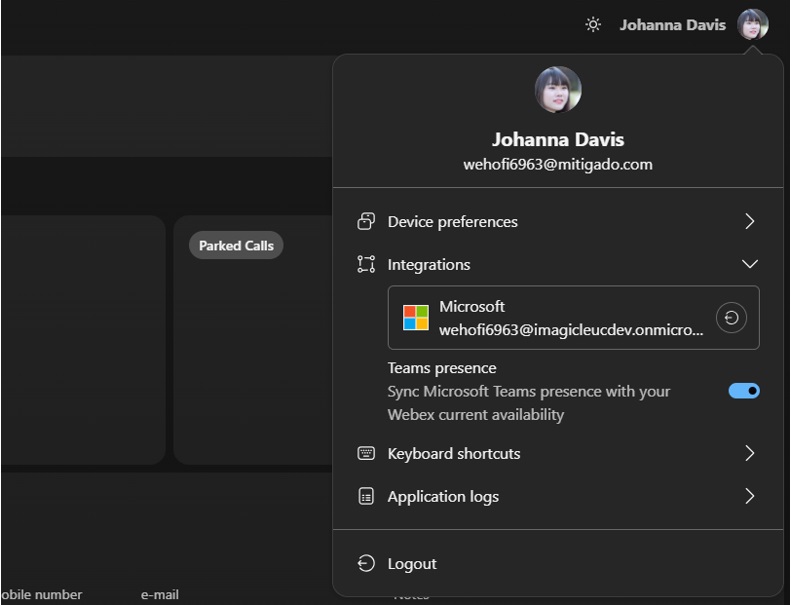
La activarea funcției Microsoft Presence, Consola participant calculează starea de disponibilitate pe baza informațiilor preluate de Webex și Microsoft Teams. Consola participant afișează starea în insigna avatarului de prezență. Când Microsoft Teams preia starea de prezență, fereastra de instrumente pentru insignă afișează aceste informații.
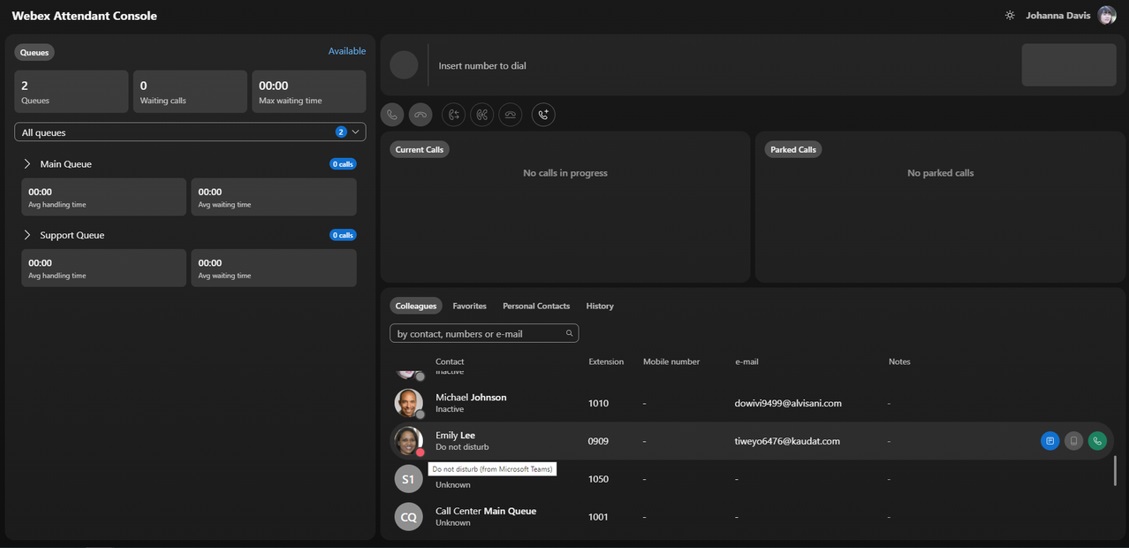
Activarea funcției Calendar
Înainte de a începe
În calitate de administrator Azure al unei organizații, asigurați-vă că acordați consimțământul pentru accesarea aplicației enterprise Imagicle Webex Attendant Console Connector . Puteți oferi consimțământul pe portalul Microsoft Azure. Parcurgeți acești pași pentru a acorda permisiunea:
-
Lansați aplicația Microsoft Azure și utilizați câmpul de căutare pentru a găsi Webex Attendant Console.
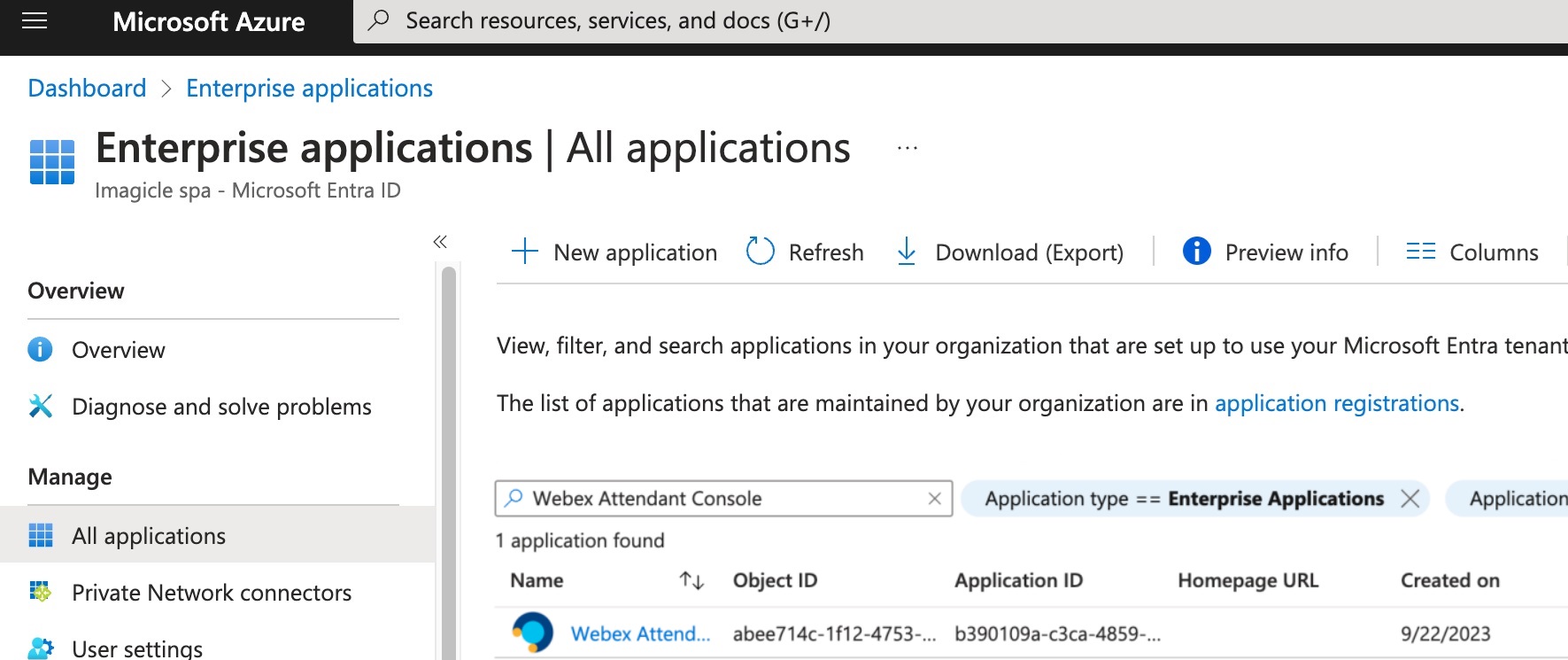
-
Navigați la . Faceți clic pe butonul Acordați consimțământul administratorului pentru ....
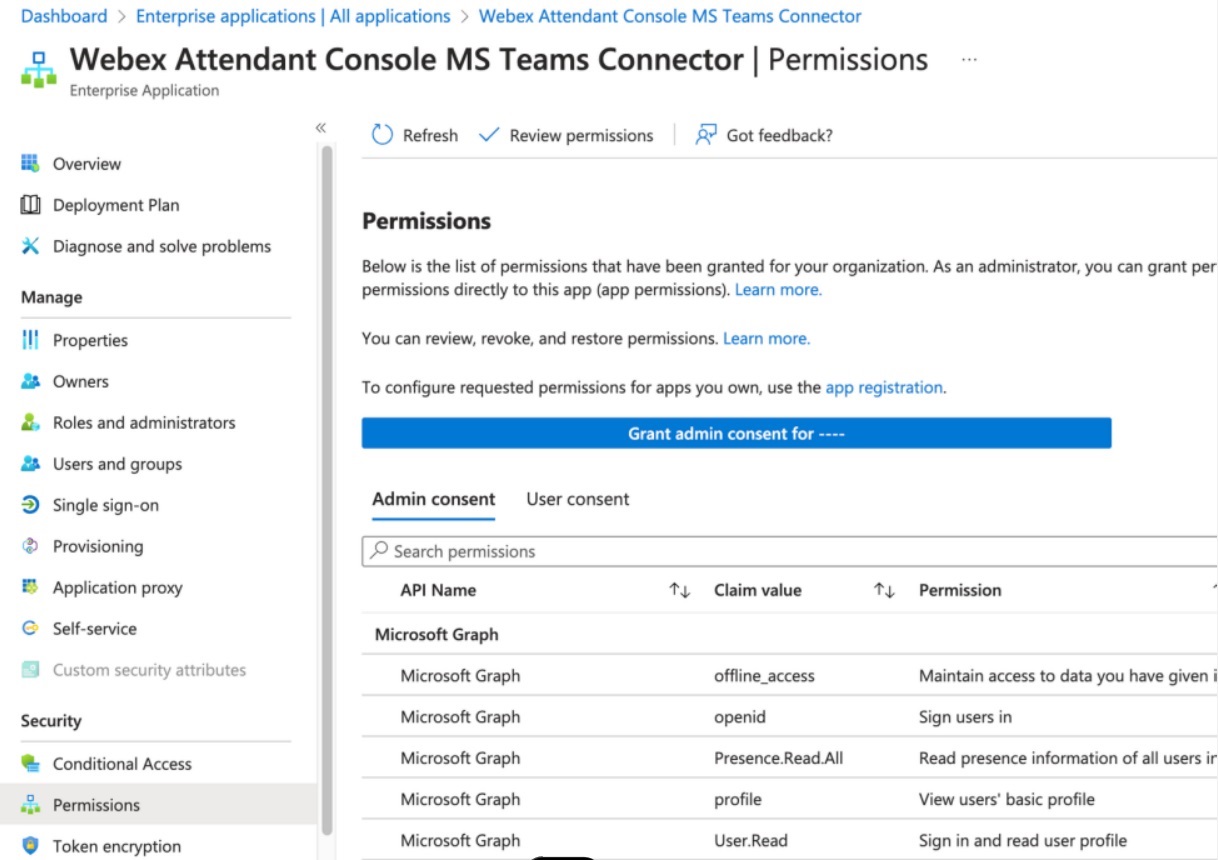
-
Se afișează fereastra Permisiune solicitată. Citiți cererea și faceți clic pe Accept pentru a vă da consimțământul.

Puteți activa funcția Calendar din meniul principal, sub setarea Integrări.
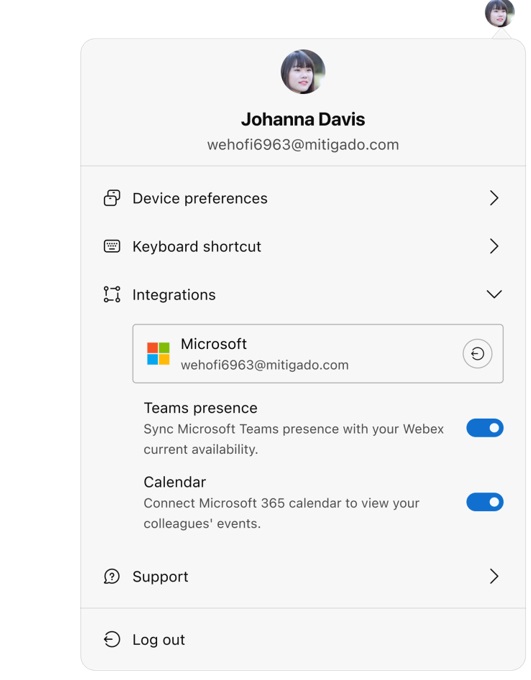
La activarea funcției Microsoft Calendar, se afișează un buton Calendar atunci când un utilizator plasează cursorul peste un coleg sau peste un rând de tabel preferat. La clic pe butonul Calendar, apare o fereastră pop-over care afișează evenimentele viitoare pentru colegul (sau favoritul) selectat.
